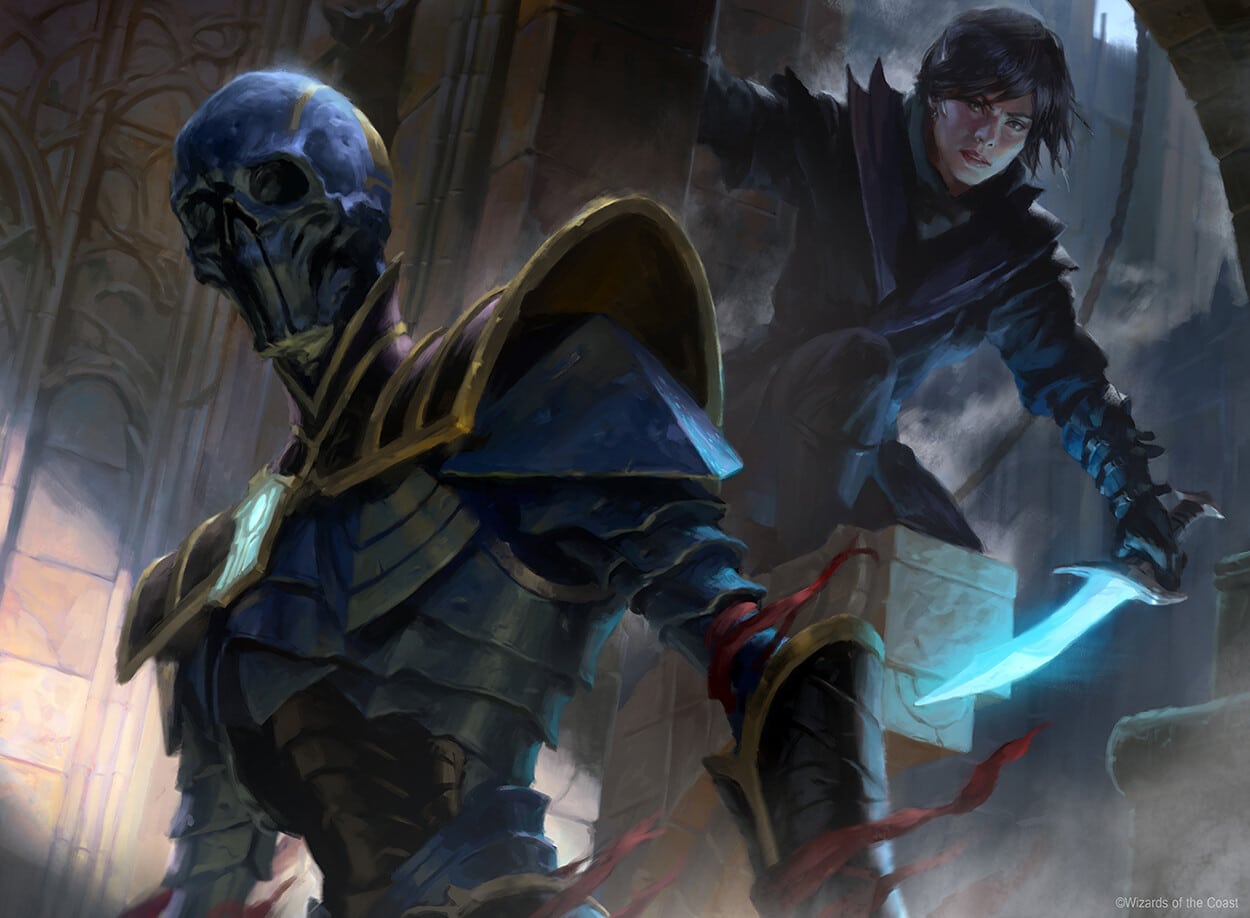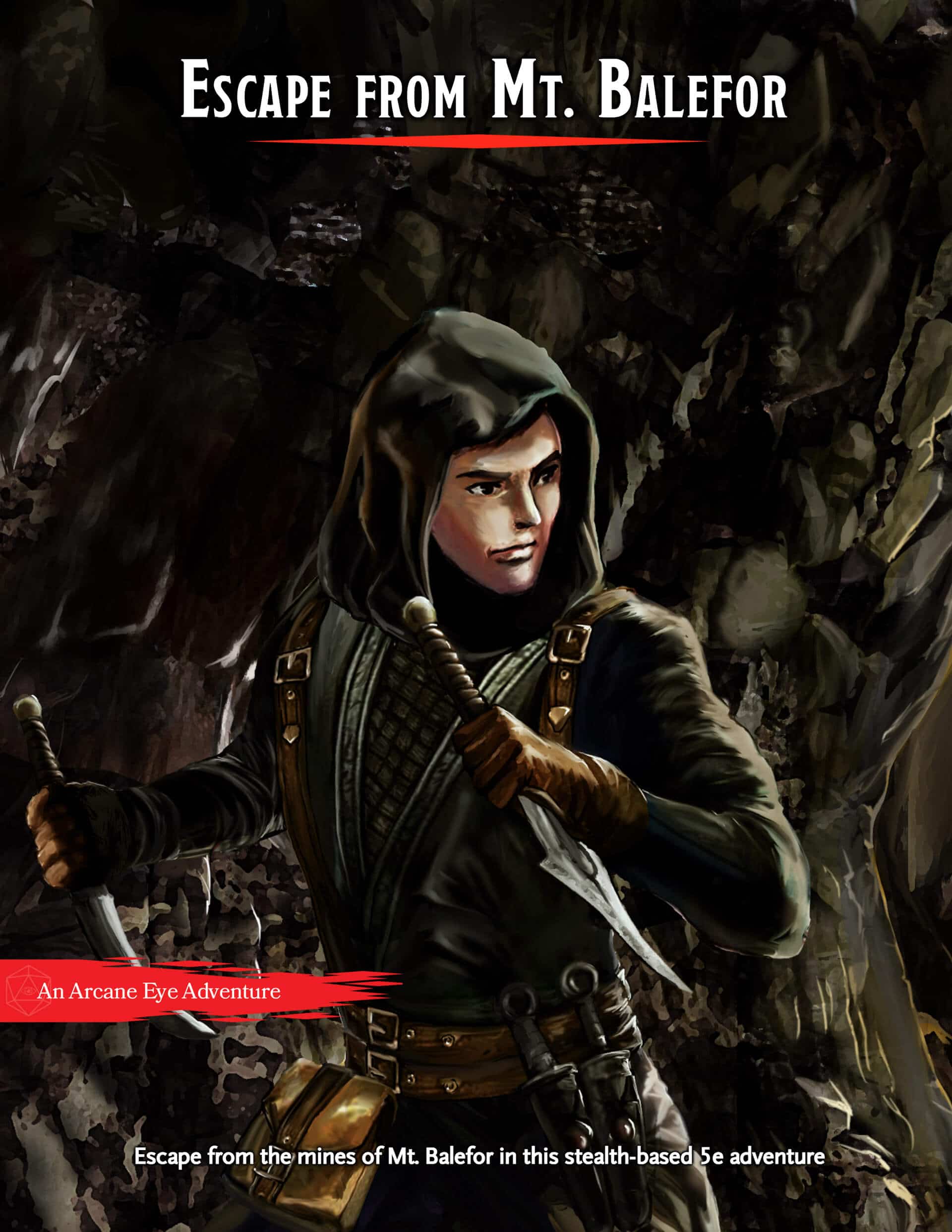Skulker 5e
Published on March 12, 2022, Last modified on July 25th, 2023
If remaining unseen and attacking from a distance are among the priorities for your build, the Skulker feat can help you get there.

Stealth Mission - Wizards of the Coast - Taylor Ingvarsson
Arcane Eye may earn a small commission from affiliate links in this article.
Learn more.What Is Skulker 5e?
We all have seen those iconic scenes: an archer lays in wait, arrow ready to fly to an unsuspecting target. With D&D 5e, we get a feat that allows you to recreate this scene by making you a stealthier, ranged badass.
How Does Skulker Work?
As long as you have at least 13 Dexterity, you can pick up this feat. Once you do, you get these three abilities:
- Dim light doesn’t impose any disadvantage on your Wisdom (Perception) checks that require you to see.
- You can try to hide if you’re lightly obscured from the creature you’re hiding from.
- As long as you’re hidden from a creature and miss an attack with a ranged weapon attack, it won’t reveal your position.
Those who want to stay hidden at all times want this feat and anyone trying to make a sniper-like build happen.
Is Skulker Good?
We gave Skulker a C Tier rating In our 5e Feats Tier List, making it a below-average feat in D&D 5e.
This feat certainly has some use for a very specific build. Being able to hide while lightly obscured is a wood elf trait, and being able to see in dim light comes with Darkvision, so if you are a human rogue or ranger, this could be a good pick-up.
This is also good for Underdark campaigns because seeing in darkness with darkvision is still considered dim light. This means you’d be able to hide from creatures while navigating dark areas, even if they normally have no issues seeing in the dark, because you’ll be lightly obscured.
Skulker 5e Interactions
You’d be surprised to learn that there aren’t a lot of interactions with this feat. Because it’s not combat-centric, it often just operates as written. However, there are a few edge cases, such as:
- For Wood Elves, they can already use their Mask of the Wild ability to count as being lightly obscured in nature.
- An enemy with blindsight or true sight will negate any hiding attempts with this feat.
- Darkvision allows you to treat darkness as dim light. This means a character with skulker will be lightly obscured and can attempt to hide from creatures who have darkvision while in dark areas.
Which 5e Classes Make the Most of Skulker?
The color code below has been implemented to help you identify, at a glance, how good the Skulker 5e feat is for a specific class/subclass.
- Red isn’t going to contribute to the effectiveness of your character build at all
- Orange Situationally good, but a below-average option otherwise
- Green is a good option
- Blue is a great option, you should strongly consider this option for your character
- Sky Blue is an amazing option. If you do not take this option your character would not be optimized
Skulker is a very build-dependant feat and only works well on those who prefer to play stealthier characters. This means that most classes rule it out unless they forego optimal builds for interesting character design (which we love but isn’t everyone’s cup of tea).
Artificer: In most cases, this feat doesn’t mesh well with artificers unless your DM approves firearms and you opt for some sort of sniper-gun build. Even then, this feat doesn’t work with your Steel Defender or Eldritch Cannon, making it pretty subpar all around.
Barbarian: There’s rarely a situation where a barbarian would be sneaking around with ranged weapons for very long, making this feat useless in most cases.
Bard: This feat makes sense since most bards will be far away from the front line. It allows them to hide and support the team, playing as a pseudo-rogue. This feat works incredibly well for College of Whispers bards, as it will enable them to torment their foes from afar.
Cleric: It’s rare for clerics to be too far away from the frontlines, making this feat challenging to recommend. Trickster Domain clerics might find some use out of it, but the rest of the subclasses won’t benefit.
Druid: Most ranged druids prefer to be spellcasters over ranged weapons, making this feat a little less impressive. There’s probably some good space to explore with a stealthy Wild Shape-based build here, but that only adds to hiding and not to your combat.
Fighter: It’s pretty easy to play a DEX-based, ranged sniper fighter, pairing it with the archery fighting style. Battle Master and Samurai both make great starting options for this build, and you can open it up to multiclassing later for better benefits.
Monk: The only monk subclass made for a stealthy playstyle is the Way of Shadow. While they can’t use ranged weapons, they can still benefit from the feat for ultimate stealth. Way of the Kensei monks can also use ranged weapons, but they aren’t always looking for a sneaky playstyle.
Paladin: There are very few times where a paladin will choose stealth for a very long time. None of the subclasses support a stealthy ranged attack build, so you’re better off skipping this.
Ranger: The ultimate archer class; these are excellent picks if you want to go for a stealthy character. Gloom Stalker, in particular, would benefit the most from this; it pairs perfectly with this style of play
Rogue: Another amazing option for archer rogue builds who have gone with a race that doesn't provide darkvision. Helps you pull off sneak attacks and hide. Still useful without making ranged attacks, though you will find the most benefit from this feat with ranged builds.
Sorcerer: Sorcerers won’t find anything useful out of this feat. They’re much better off spellcasting than wasting their turns hiding with ranged weapons.
Warlock: Unfortunately, eldritch blast just doesn't jive with stealth because only the first beam is rolled with advantage.
Wizard: Wizards won’t find anything useful out of this feat. They’re much better off spellcasting than wasting their turns hiding with ranged weapons.
Conclusion
Taking a stealthy approach to combat and gameplay isn’t for everyone, and 5e offers a few ways to support that playstyle. The Skulker feat sort of doubles down on that idea and gives better options for those who prefer it. However, it doesn’t work with every class because it’s such a narrow playstyle.
What are your thoughts on Skulker? Is there a missed opportunity with this feat we didn’t catch? Let us know in the comments, and make sure your eyes stay sharp!
Fill out the form below to receive Escape From Mt. Balefor for free!
Or follow us on Instagram, Twitter, and YouTube.
Jeff Nabors
Jeff Nabors has been playing D&D ever since he stumbled upon the 3.5E core books in his high school library. When he isn’t running a campaign or designing a game, you can find him on Twitch, writing about game design, or staring off into the endless abyss.


From what I understand about darkvision, this feat would allow a character to operate in pitch darkness without incurring disadvantage from what is, to them, dim light. Still very niche but an interesting angle to consider for Underdark campaigns or any character that relies on absolute darkness.